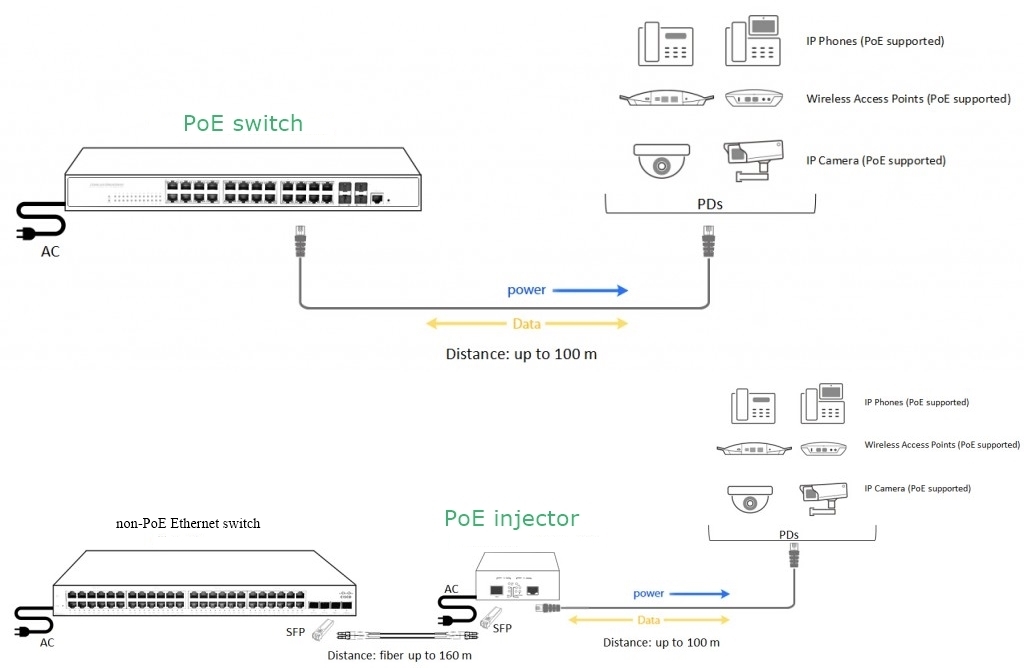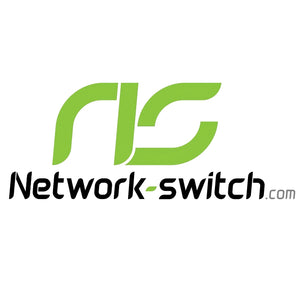Power over Ethernet (PoE) technology has become an indispensable element of modern network infrastructures, powering networked devices like IP cameras, VoIP phones and wireless access points. PoE switches offer an efficient and cost-effective means of transmitting both power and data over one Ethernet cable; this guide will outline everything there is to know about them as well as their benefits, applications and how you can select the ideal switch for your needs.
Understanding Power over Ethernet (PoE) and Network Switches: The Basics You Should Know
What Is PoE (Power over Ethernet)?
PoE, or Power over Ethernet, is a technology which enables Ethernet cables to transport electrical power as well as data for remote devices over one cable - eliminating the need for separate power sources and streamlining network infrastructure by consolidating both functions into one solution.
PoE operates under IEEE 802.3af and IEEE 802.3at standards, while its successor IEEE 802.3bt provides even higher power outputs that enable it to power more demanding devices such as HD cameras, Wi-Fi access points and digital signage systems. Power delivered ranges from 15.4 watts per port in original PoE (802.3af) standards up to 100 watts per port when using PoE++ (802.3bt) standards.

What Is a Network Switch?
A network switch is an electronic device used to link multiple devices in a local area network (LAN), allowing them to communicate. It works by routing data packets directly to their destination device using their MAC address rather than broadcasting to all connected devices at once like hubs do.
PoE switches not only manage network traffic, but they also supply electrical power over Ethernet cables - simplifying device installations and installation. In PoE devices, one cable serves both functions simultaneously allowing devices to be powered without needing separate power sources.
Explore Available PoE Switch Options: Which Switch Suits Me Best?
PoE switches come in various configurations to meet specific needs. Among these are:
Unmanaged PoE Switches: These switches offer convenient plug-and-play solutions for small networks or simple installations with no configuration necessary - simply connect devices directly to them to get going!
Managed PoE switches offer advanced features, including the ability to monitor and configure network performance, manage VLANs, prioritize traffic and ensure security. They are an ideal solution for larger networks that need greater control and flexibility.

Smart PoE Switches: These switches offer an affordable middle ground between unmanaged and managed switches, offering some basic management features such as VLAN support and QoS quality of service but are less complex and less costly than fully managed models.
PoE Injector Switches: These switches enable devices that don't natively support PoE by injecting power through standard Ethernet cables to add PoE functionality for devices such as IP cameras or wireless access points.

Why PoE Switches Are Essential in Modern Network Infrastructure?
PoE switches offer numerous advantages that make them essential components of modern network infrastructure:
Simplified Cabling: PoE cables combine power and data transmission in one cable, making installation simpler and reducing the number of cables necessary in a network - this feature is particularly advantageous in tight spaces where providing power outlets is difficult.
Cost Savings: By eliminating the need for separate power cables and outlets as well as electrical installations, PoE switches reduce both material and labor costs in network setup.
Flexibility: PoE allows devices like wireless access points and IP cameras to be installed even where there are no power outlets nearby, giving more freedom in where devices can be placed without being restricted by proximity to power sources.
Centralized Power Management: With Power over Ethernet (PoE), power is centrally managed through the switch, making it simpler to monitor, troubleshoot and address power-related issues. Furthermore, maintenance becomes much simpler as all devices can be powered off/on remotely through this method.
Scalability: PoE makes adding new devices much simpler; simply connect the new device directly to a PoE switch for both power and data without needing extra infrastructure.

Common Devices Powered by PoE Switches
PoE switches are great for powering devices that need both electricity and data. Here are some examples:
IP Cameras: PoE simplifies surveillance installations by simultaneously providing both power and data to cameras via one Ethernet cable, eliminating the need for additional adapters and facilitating installation in remote or outdoor locations.
Wireless Access Points (WAPs): PoE switches provide Wi-Fi access points with power, enabling flexible placement without requiring separate electrical outlets - perfect for expanding wireless coverage in large offices and warehouses.
VoIP Phones: Many modern office phone systems use VoIP technology. PoE enables these phones to transmit both data and power at the same time, making setup much simpler while eliminating extra power cables.
Networked Lighting: Smart buildings and industrial environments make use of PoE-powered LED lighting systems, which are both energy-efficient and easy to control from across the network.
Access Control Devices: PoE can make powering access control devices such as card readers, biometric scanners and other security systems simpler while guaranteeing reliable operation.

PoE Switch Limitations: What Should Be Considered Prior to Selecting One
While PoE switches offer many benefits, they also come with some drawbacks:
Power Limitations: Unfortunately, PoE offers only limited power, meaning some high-powered devices might not be supported under older standards such as 802.3af. For such devices, PoE+ (802.3at) or PoE++ (802.3bt) standards should be preferred for best results.
Distance Limitations: Ethernet cables are limited to a maximum length of 100 meters (appox 328 feets). Beyond this point, signal degradation may occur, necessitating repeaters or fiber optic solutions in order to extend coverage.

Device Compatibility: Not all devices can support power over Ethernet (PoE). Devices designed specifically to accept power must meet certain standards, so making sure device compatibility is a key consideration in setting up a PoE network.
Heat Generation: PoE switches that power multiple devices can generate extra heat, necessitating appropriate cooling mechanisms in high-density or industrial applications.
PoE Network Switches | Top 5 Brands
In the world of PoE switches, here are five leading brands you'll want to consider when you're looking for a quality, dependable option.
Cisco: Cisco's PoE switches, known for their superior management features and scalability, are ideal for large enterprise networks and large setups.
Ubiquiti Networks: Budget PoE solutions from a reputable manufacturer that are easy to set up and work well. Home users and small businesses especially like their UniFi series.
TP-Link: TP-Link makes excellent budget budget-friendly PoE switches, well suited to small office setups. Their programs are easy to use and offer good performance at reasonable prices.
Netgear: Strongly positioned in the small to medium-sized networks, Netgear’s PoE switches offer PoE+ (802.3AT) support, smart management options, and reasonable pricing.
D-Link: D-Link has a range of PoE switches for both small business and larger deployments capable of offering reliable performance at a reasonable price.
Selecting the Right PoE Switch for Your Networking Needs
Here are some things to consider when choosing the best PoE switch for your network:
Choosing the Right Power: Check that the switch will deliver enough power for your devices — be it standard PoE or PoE+.
Port Count: Opt for a switch with sufficient ports for all your devices.
Management Features: Managed switches offer greater control over your network, but unmanaged switches are more basic and often cheaper.
Network Speed: Consider your network speed (for example, 1Gbps or 10Gbps) and select a PoE switch that can accommodate the bandwidth requirements for your data traffic.
Why Are PoE Switches Important for Today's Networking?
PoE switches play a crucial role in modern networks by delivering both power and data through a single Ethernet cable. They simplify installations, cut costs, and provide greater flexibility, making them very beneficial. Whether you're launching a small business network or expanding a larger one, PoE switches can greatly improve your network's efficiency and ability to grow.
If you’re interested in PoE solutions for your network, think about reaching out to one of the top brands mentioned earlier for more details on their products. For additional information, don't hesitate to contact our sales team for tailored guidance in choosing the right PoE switch for your needs.

Data Supported by Belowings:
- PoE – Wikipedia
- Cisco PoE Solutions
- Ubiquiti Networks PoE
- TP-Link PoE Switches
- Netgear PoE Switches
- D-Link PoE Switches
Did this article help you gain a better understanding of network switches and their functionality? Share your thoughts with us on Facebook and LinkedIn – we’d love to hear from you!


 https://network-switch.com/pages/about-us
https://network-switch.com/pages/about-us

